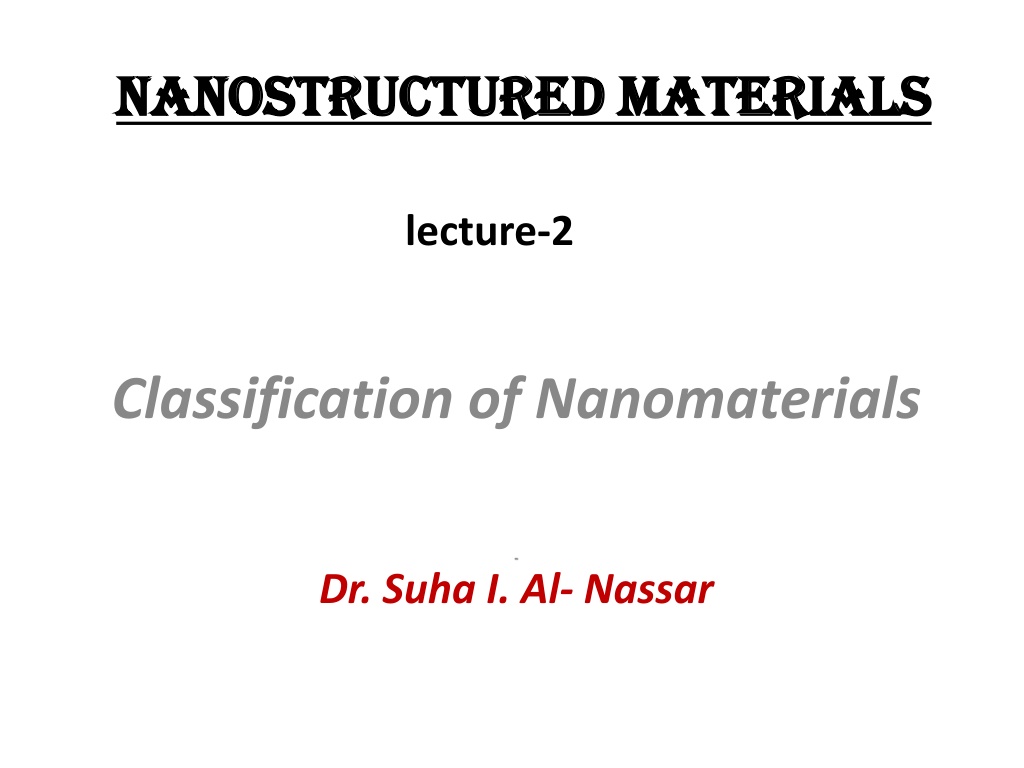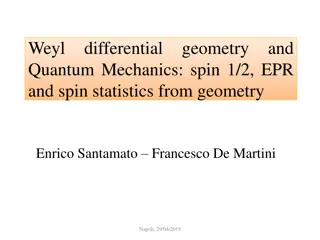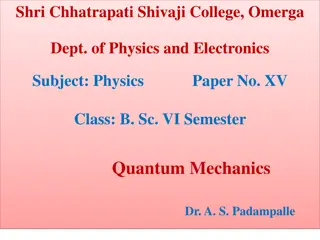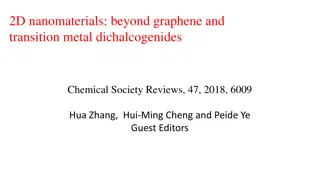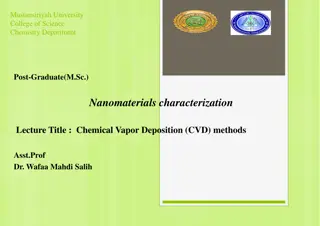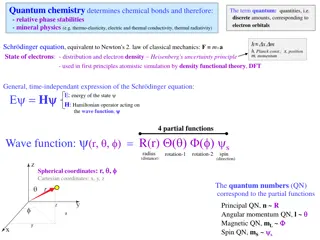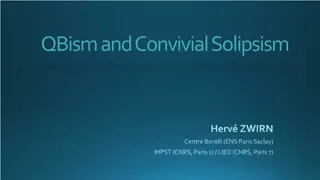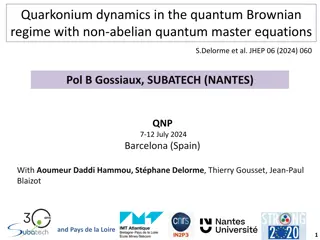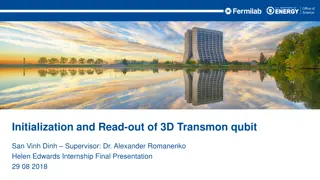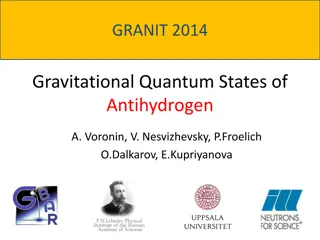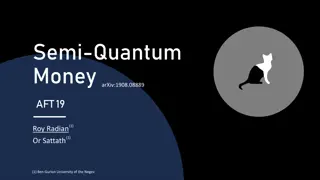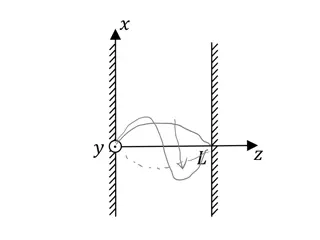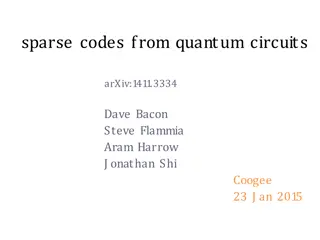Understanding Classification of Nanomaterials and Quantum Phenomena
Nanomaterials are classified into different types such as nanocrystals and quantum dots, each exhibiting unique properties at the nanoscale. Quantum dots, zero-dimensional systems, show quantum confinement effects leading to tuneable light emission. One-dimensional structures like nanowires and nanotubes offer potential applications in various fields like data storage and electronics. Understanding these classifications is crucial for exploring the fascinating world of nanotechnology.
Download Presentation

Please find below an Image/Link to download the presentation.
The content on the website is provided AS IS for your information and personal use only. It may not be sold, licensed, or shared on other websites without obtaining consent from the author. Download presentation by click this link. If you encounter any issues during the download, it is possible that the publisher has removed the file from their server.
E N D
Presentation Transcript
Nanostructured Materials Nanostructured Materials lecture-2 Classification of Nanomaterials Dr. Suha I. Al- Nassar
these nanoparticles include single crystal, polycrystalline and amorphous particles. If the nanoparticles are single crystalline, they are often referred to as nanocrystals. When the NPs have dimension is sufficiently small and quantum confinement effects are observed, the common term used to describe such nanoparticles is quantum dots. Quantum dot: It is a zero dimensional system The electron movement was restricted in entire three dimensions. These are nanoparticles of semiconducting material, such as cadmium, selenium, indium or even rare earth materials. Because of the small size, electrons are constrained in all three dimensions and therefore behave more like electrons in a discrete atom than in a crystal. This means that transitions between well-defined energy levels occur, as in discrete atoms. Hence if electrons are excited to higher levels, they will emit light of a specific frequency when they drop back down to lower levels.
The frequency of light is tuneable by adjusting the dimensions of the nanoparticle. In the reverse process, absorption of light of specific frequencies can excite electrons into the conduction band, increasing conductivity. Figure 1 shows the difference in the relative sizes of the energy gap between occupied energy levels (the valence band) and unoccupied energy levels (the conduction band) of a quantum dot and a semiconductor. The smaller the quantum dot, the larger the energy gap between the energy levels and hence the higher the frequency of light emitted.
This type has been called by a variety of names such as: whiskers, fibers or fibrils, nanowires and nanorods. In many cases one-dimensional systems take into account carbon-based, metal-based or even oxide-based systems. Nanotubues and nanocables are also considered one-dimensional structures if the extension over one dimension is predominant over the other types . Quantum Wire : It is a one-dimensional system The electron can move in one direction and restricted in two directions. Quantum wires are ultra fine wires or linear arrays of Nano dots, formed by self- assembly They can be made from a wide range of materials such as Semiconductor Nanowires made of silicon, gallium nitride and indium phosphide. Nanowires have potential applications in high-density data storage, either as magnetic read heads or as mpatterned storage media . In electronic and opto- electronic Nanodevices, for metallic interconnects of quantum devices and Nanodevices.
Electrical wires made on a macroscopic scale possess an electrical resistance which depends only on the length and area of the wire, according to the well-known formula: where is the resistivity of the material from which the wire is made, l is the length in m and , A is the cross-sectional area of the wire in m2. However, if wires are made sufficiently thin, the electrons become constrained in the dimensions at right angles to the length of the wire and this causes their energies to be quantized
They are another important nanostructure, they include many shapes such as nanofilms, nanolayers, nanocoatings and nanodiscs, thus they have been a subject of intensive study for almost a century. Quantum well: It is a two dimensional system The electron can move in two directions and restricted in one direction. A quantum well is formed by sandwiching a semiconductor material (for example, gallium arsenide) between two layers of a different semiconductor material with a greater band gap (for example, aluminium arsenide).
The significance of gallium arsenide is that its band gap (the energy difference between the valence band and the conduction band) is described as direct , which means that electrons can be excited to the conduction band (and vice versa) without needing to undergo a significant change in momentum. This makes the process much more efficient and explains why substances like gallium arsenide are used in optical devices such as lasers. Conventional lasers have used thicknesses of gallium arsenide of above 100 nm (hence just outside the nanoscale); quantum well lasers have thicknesses of around 10 nm. The quantum behaviour of these systems means that, as with quantum dots, the wavelength of light emitted can be tuned by adjusting the thickness of the layer.
Three-dimensional nanomaterials, also known as bulk nanomaterials, are relatively difficult to classify. However, it is true to say that bulk nanomaterials are materials that are not confined to the nanoscale in any dimension. These materials are thus characterized by having three arbitrarily dimensions above 100 nm The arrangement of three-dimension nanosystem consists of both crystalline and amorphous nanostructures, such as nanocrystals have a very large variety of ordered nanoarranged porous materials.
